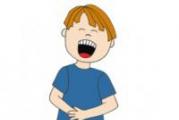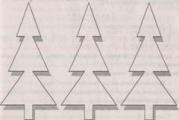The initial form of the verb is protruded. Initial verb form: rule, definition and search
Let's talk about the initial form of the verb (it is also often called the indefinite, or infinitive). It is necessary to know about it because in the huge construction of human knowledge, the initial form of the verb is one of the basic, bearing elements.
What is a verb
Those who graduated from school long ago and managed to forget a lot should be reminded: a verb is a part of speech that describes an action. I read, go, do, write, draw, dream - all these words are verbs that differ only in their features.
About the verb
In Russian grammar, verbs have 7 features: tense, type, face, mood, gender, number, voice; conjugation is often considered as a sign. Not in every case it is legitimate to talk about a single feature or all of them at once. In particular, the absence of a face is characteristic of it, and the present, like the future, makes conversation about the gender of the verb pointless.
It is pointless to study these signs, their differences from each other, as well as the possibility of conjugation, without establishing the main thing: what is the initial form of the verb. A synonym for this definition is the concept of an indefinite form and the term "infinitive".
The infinitive expresses the verb in the dictionary. It is not by chance that this form is called initial - it really is a start for further study of the indicated parts of speech. Questions of the initial form of the verb - "What to do?" and "What to do?" Examples of the infinitive: lie down and forgive, cut and run, leave and return, stop by and examine. Well, now you can talk about verbs in more detail, having examined in more detail their distinctive features.

About face and time
Dealing with (there are 3) is easy by determining who exactly reports the described action. The face reflects the attitude of the communicator to the ongoing process. The first singular is the actions of the communicator himself: I do, I walk. The same is in the plural - the actions of the group represented by the speaker: we do, we go. The verbs of the second person characterize the actions of the interlocutor of the reporting person or the group that he represents: do, walk, do, walk. A third party, regardless of the number, is the actions of outsiders who do not participate in the dialogue: doing, walking, doing, walking. To understand which person a verb belongs to, the corresponding noun or pronoun will help.
The tenses of the verb characterize the attitude to the moment when the described action is performed. There are 3 forms of the verb, representing the present, past and future tense. I go and do examples. For the past and future tense, there are similar options: walked, did, will walk, will do.
Important to remember! The initial form of the verb is impersonal. The concept of a person, number, time is also inapplicable to the infinitive.
Gender and mood of the verb

Changes in verbs occur not only in numbers, persons or tenses, but also in gender, like nouns. There are three genders: feminine, masculine, neuter - a pronoun or noun used with it can also help to determine the belonging of a verb to them. The gender of the verb is manifested exclusively in the past tense and is determined by the end: walked, walked, did. The concept of gender is not applicable.
An important characteristic of the verb is its mood, which can be indicative, imperative or conditional. Using describe actions that either have happened, or are happening in the present moment, or will happen later. Examples of the indicative walk, walk, will walk, did, do, will do. The conditional mood informs about the actions of the desired or those that are possible under certain conditions. When forming a conditional mood, the initial form of the verb without an ending, the suffix "l", and the particle "by" are taken as a basis. Examples of conditional mood: would walk, would do. Verbs represent a command, an order, an invitation to action. Examples: do it, go, fetch it! The particle "-ka" is often added to such verbs, which somewhat softens this order: do it, go!

About the types of the verb
In its own way, it can be attributed to perfect and imperfect. Imperfect ones characterize an action without any indication of its end, and as an infinitive the question "What to do?" Examples: walk, paint. In their perfect form, these same examples will look different: go, draw, because here the verbs describe the finished action. The question that can be put to their infinitive is "What to do?"
Most verbs have both types: draw-draw, burn-burn, eat-eat. However, there are verbs without a paired form. These include, in particular, "belong" - here only an imperfect view is possible. Or "find yourself" - this word, on the contrary, can exist only in a perfect form. There are also two kinds of verbs (such as "execute") - they combine the meanings of both kinds. Often in the case of two-species, the ending of the verbs in the initial form looks like "-iate" ("emigrate").
Transitivity and voice of the verb
Properties such as transitivity and voice of a verb indicate its relationship with other objects. The concept of transitivity indicates the presence of an object of action. Examples of transitive verbs: eat (soup), read (magazine) - here soup and magazine are the objects of action. Intransitivity of a verb implies the absence of an application object. Examples of an intransitive verb are work, live (there is no specific object to which this action is applied). A special case of intransitive verbs is reflexive; here the one who produces the action is at the same time the one to whom it is directed. In these cases, the initial form of the verb ends in "-sya": swim, laugh, worry.

The voice of the verb deals with the relationship between subjects and objects of action. The active voice characterizes the active construction. For example: the cat ate fish. The cat (subject) performed an active action over the object (fish), the voice of the verb "ate" is real. The same idea, formulated in a different way: the fish was eaten by the cat. This construction, unlike the previous one, is passive, and therefore the voice of the verb in it is passive.
And again about the infinitive
Knowing the characteristic features of verbs, it is worth talking about the infinitive in more detail. How to determine the initial form of a verb? It's very simple to ask a question. If in relation to the performed action you can ask: "What to do?" or “What to do?” means that the form of the verb describing this action is indefinite. Of all the features considered, only the form is inherent in the infinitive, as well as such properties as transitivity and recurrence.
The infinitive is formed by adding a formative suffix to the root of the word. The characteristic suffix in the initial form of the verb is "-ty", "-ty", "-ch". Examples of the infinitive: climb, carry, oven.

About conjugation of verbs
The conjugation of a verb is called its change depending on persons and numbers: I write, he writes, we write, etc. Each verb can be attributed to the first or second conjugation; it is necessary to know about this accessory in order to achieve the correct spelling for any particular case. Errors in the conjugation process are especially common in the case of unstressed verb endings.
For the correct definition of conjugations, you need to know what the initial form of the verb is. The first conjugation is represented by all the mentioned parts of speech with the ending "-to" - to train, to inform. To the same conjugation belongs a number of verbs ending in "-et", "-at", "-yat", as well as "lay" and "shave" (ending "-it"). The second conjugation is represented by all verbs with the ending "-it", with the exception of those already mentioned. This also includes individual verbs with the ending "-at" and "-yat", if the stress falls on them (lie down, stand). The second conjugation also includes some of the verbs (look, hate, etc.), which cannot be adjusted to any standards - you just need to remember them. Knowledge of the rules for conjugation of verbs is a guarantee of correct spelling, and just a requirement for literacy. By the way, the infinitive itself is not conjugated and does not change depending on persons and numbers.
Verbs in a sentence
The roles of these parts of speech in a sentence can be different. Most often, the verb acts as an ordinary (simple) predicate: "Tolya bought bread." There are frequent cases of a complex verbal predicate: "Vanya decided to run to the store." In the present case, the whole construction becomes predictable (I decided to run away), and the second verb in it is represented by the infinitive. Sometimes a verb can act as an inconsistent definition: “I didn't like the idea of \u200b\u200bgoing there” (going there is an inconsistent definition).
The Russian language is unique in its own way in that it allows for more complex, truly fantastic constructions. “We decided to send to go find to buy a drink” is a sentence of 6 verbs, 5 of which represent an infinitive with a complete meaning and compliance with the rules of grammar. Foreigners are crying!

Conclusion
Most linguists are unanimous in the opinion that the first word uttered by an ancient man was a verb. It is unlikely that our distant ancestor in those harsh times needed adjectives in the lexicon to describe the beauty of the night sky, and most of the nouns he could well have replaced with a pointing gesture in their direction. But the command "Run!", Given to a fellow tribesman, could well have saved that life, the word "I want" and the corresponding movement towards the mammoth carcass also left no doubt about what was said. If necessary, only one verb could well replace all other parts of speech.
By the way, modern approaches to the study of foreign languages \u200b\u200balso imply the primary study of verbs as the main means of expressing human needs. Naturally, native speakers also need a good knowledge of these parts of speech, their signs and properties. And the infinitive plays a special role in the study of verbs.
1. Independent parts of speech:
- nouns (see morphological norms of noun);
- verbs:
- participles;
- gerunds;
- adjectives;
- numerals;
- pronouns;
- adverbs;
2. Service parts of speech:
- prepositions;
- unions;
- particles;
3. Interjections.
None of the classifications (according to the morphological system) of the Russian language fall into:
- words yes and no, if they act as an independent sentence.
- introductory words: so, by the way, total, as a separate sentence, as well as a number of other words.
Morphological analysis of a noun
- the initial form in the nominative case, singular (except for nouns used only in the plural: scissors, etc.);
- own or common noun;
- animate or inanimate;
- genus (m, f, Wed);
- number (singular, plural);
- declination;
- case;
- syntactic role in a sentence.
Plan for morphological parsing of a noun
"The kid is drinking milk."
Kid (answers the question who?) - noun;
- initial form - baby;
- constant morphological signs: animate, common noun, concrete, masculine, 1st declension;
- inconsistent morphological features: nominative, singular;
- when parsing a sentence, it acts as a subject.
Morphological analysis of the word "milk" (answers the question of whom? What?).
- initial form - milk;
- constant morphological characteristic of the word: neuter, inanimate, material, common noun, II declension;
- morphological changeable signs: accusative case, singular;
- the sentence is a direct addition.
Here is another example of how to make a morphological analysis of a noun, based on a literary source:
"Two ladies ran up to Luzhin and helped him to get up. He began to knock the dust off his coat with his palm. (Example from" Luzhin's Defense ", Vladimir Nabokov)."
Ladies (who?) - noun;
- initial form - lady;
- constant morphological signs: common noun, animate, concrete, feminine, I declension;
- fickle morphological noun characteristics: singular, genitive;
- syntactic role: part of the subject.
Luzhin (to whom?) Is a noun;
- initial form - Luzhin;
- faithful morphological characteristic of the word: proper name, animate, specific, masculine, mixed declension;
- inconsistent morphological features of a noun: singular, dative;
Palm (what?) - noun;
- initial form - palm;
- constant morphological signs: feminine gender, inanimate, common noun, specific, I declension;
- inconsistent morpho. signs: singular, instrumental;
- syntactic role in context: addition.
Dust (what?) Is a noun;
- initial form - dust;
- main morphological features: common noun, real, feminine, singular, animate not characterized, III declension (noun with a zero ending);
- fickle morphological characteristic of the word: accusative case;
- syntactic role: addition.
(c) Coat (From what?) - noun;
- initial form - coat;
- constant correct morphological characteristic of the word: inanimate, common noun, concrete, neuter, non-declining;
- morphological signs are unstable: the number cannot be determined by the context, the genitive case;
- syntactic role as a member of a sentence: addition.
Morphological analysis of the adjective
An adjective is a significant part of speech. Answers the questions Which one? Which one? Which one? What kind? and characterizes the signs or qualities of the subject. Table of morphological features of the adjective:
- initial nominative, singular, masculine;
- constant morphological features of adjectives:
- discharge, according to the value:
- - high quality (warm, silent);
- - relative (yesterday's, reading);
- - possessive (hare, mother's);
- the degree of comparison (for quality ones, for which this feature is constant);
- full / short form (for quality ones, in which this feature is permanent);
- inconsistent morphological features of the adjective:
- qualitative adjectives change in the degree of comparison (in comparative degrees, a simple form, in excellent ones - a complex one): beautiful-beautiful-most beautiful;
- full or short form (only quality adjectives);
- gender trait (only in the singular);
- number (consistent with a noun);
- case (consistent with a noun);
- syntactic role in a sentence: an adjective is a definition or part of a compound nominal predicate.
Plan of morphological parsing of an adjective
Sample sentence:
The full moon rose over the city.
Full (what?) - adjective;
- initial form - full;
- permanent morphological signs of an adjective: qualitative, full form;
- inconsistent morphological characteristics: in a positive (zero) degree of comparison, feminine (consistent with a noun), nominative;
- for parsing - a minor member of the sentence, serves as a definition.
Here's another whole literary passage and morphological analysis of the adjective, with examples:
The girl was beautiful: slender, thin, blue eyes, like two amazing sapphires, and looked into your soul.
Beautiful (what is it?) Is an adjective;
- initial form - fine (in this meaning);
- constant morphological norms: qualitative, short;
- fickle signs: positive comparison, singular, feminine;
Slender (what?) - an adjective;
- initial shape - slim;
- permanent morphological features: qualitative, complete;
- inconsistent morphological characteristics of the word: full, positive degree of comparison, singular, feminine, nominative;
- syntactic role in a sentence: part of the predicate.
Slim (what?) - an adjective;
- initial form - thin;
- morphological constant features: qualitative, complete;
- inconsistent morphological characteristics of the adjective: positive degree of comparison, singular, feminine, nominative;
- syntactic role: part of the predicate.
Blue (what?) - an adjective;
- initial form - blue;
- table of permanent morphological features of an adjective: qualitative;
- inconsistent morphological characteristics: full, positive degree of comparison, plural, nominative;
- syntactic role: definition.
Amazing (what?) - an adjective;
- the initial form is amazing;
- constant signs in morphology: relative, expressive;
- inconsistent morphological features: plural, genitive;
- syntactic role in a sentence: part of the circumstance.
Morphological signs of the verb
According to the morphology of the Russian language, the verb is an independent part of speech. It can denote an action (walking), a property (limping), an attitude (equal), a state (rejoicing), a sign (whitening, showing off) of an object. Verbs answer the question what to do? what to do? what is he doing? what did you do? or what will he do? Different groups of verb word forms are characterized by heterogeneous morphological characteristics and grammatical features.
Morphological forms of verbs:
- the initial form of the verb is the infinitive. It is also called the indefinite or unchangeable form of the verb. There are no inconsistent morphological signs;
- conjugated (personal and impersonal) forms;
- non-conjugated forms: participles and participles.
Morphological parsing of the verb
- initial form - infinitive;
- constant morphological features of the verb:
- transitivity:
- transitive (used with accusative nouns without a preposition);
- intransitive (not used with a noun in the accusative case without a preposition);
- return:
- returnable (there is -sya, -s);
- irrevocable (no-sya, -s);
- imperfect (what to do?);
- perfect (what to do?);
- conjugation:
- I conjugation (do-eat, do-do, do-do, do-do, do-do / ut);
- II conjugation (one hundred-ish, one hundred-it, one-one, one-one, one hundred-one / at);
- multi-conjugate verbs (want, run);
- inconsistent morphological signs of the verb:
- mood:
- indicative: what did you do? What did you do? what is he doing? what will he do ?;
- conditional: what would you do? what would you do?;
- imperative: do it !;
- tense (in the indicative mood: past / present / future);
- person (in the present / future tense, indicative and imperative mood: 1 person: me / we, 2 person: you / you, 3 person: he / they);
- gender (in the past tense, singular, indicative and conditional mood);
- number;
- syntactic role in a sentence. The infinitive can be any member of a sentence:
- predicate: To be a holiday today;
- subject: Learning is always useful;
- addition: All the guests asked her to dance;
- definition: He has an irresistible desire to eat;
- circumstance: I went out for a walk.
Morphological parsing of the verb example
To understand the scheme, we will conduct a written analysis of the morphology of the verb using the example of a sentence:
God sent a piece of cheese to the crow somehow ... (fable, I. Krylov)
Sent (what did you do?) - part of speech is a verb;
- initial form - send;
- permanent morphological features: perfect appearance, transitional, 1st conjugation;
- inconsistent morphological characteristics of the verb: indicative mood, past tense, masculine, singular;
The following online sample of morphological parsing of a verb in a sentence:
What a silence, listen.
Listen (what do you do?) - verb;
- the initial form is to listen;
- morphological constant features: perfect form, intransitive, recurrent, 1st conjugation;
- inconsistent morphological characteristics of the word: imperative mood, plural, 2nd person;
- syntactic role in a sentence: predicate.
A plan for morphological parsing of a verb online for free, based on an example from a whole paragraph:
He needs to be warned.
Don't, let him know next time how to break the rules.
What are the rules?
Wait, then I'll tell you. Has entered! ("The Golden Calf", I. Ilf)
Warn (what to do?) - verb;
- initial form - warn;
- morphological signs of the verb are constant: perfect form, transitive, irreversible, 1st conjugation;
- non-constant morphology of a part of speech: infinitive;
- syntactic function in a sentence: part of the predicate.
Let him know (what is he doing?) - part of speech is a verb;
- the initial form is to know;
- inconsistent verb morphology: imperative, singular, 3rd person;
- syntactic role in a sentence: predicate.
Violate (what to do?) - the word is a verb;
- the initial form is to break;
- permanent morphological features: imperfect appearance, irreversible, transitional, 1st conjugation;
- non-permanent signs of the verb: infinitive (initial form);
- syntactic role in context: part of the predicate.
Wait (what to do?) - part of speech is a verb;
- the initial form is to wait;
- permanent morphological features: perfect appearance, irreversible, transitional, 1st conjugation;
- inconsistent morphological characteristics of the verb: imperative mood, plural, 2nd person;
- syntactic role in a sentence: predicate.
Came in (what did you do?) - verb;
- initial form - enter;
- permanent morphological features: perfect appearance, irreversible, intransitive, 1st conjugation;
- inconsistent morphological characteristics of the verb: past tense, indicative mood, singular, masculine;
- syntactic role in a sentence: predicate.




